Dark pots cook your food faster outside because they're highly efficient at absorbing and retaining heat. Their dark surfaces have a high emissivity rate (around 0.95 for cast iron), which means they capture more radiative heat from both sunlight and traditional fuel sources. You'll notice up to 25% faster cooking times compared to lighter-colored cookware, especially during peak sunlight hours between 10 a.m. and 2 p.m. The superior thermal conductivity of dark materials like black steel and well-seasoned cast iron also guarantees even heat distribution throughout your cooking process. Understanding these properties can transform your outdoor cooking experience.
The Science Behind Dark Pots
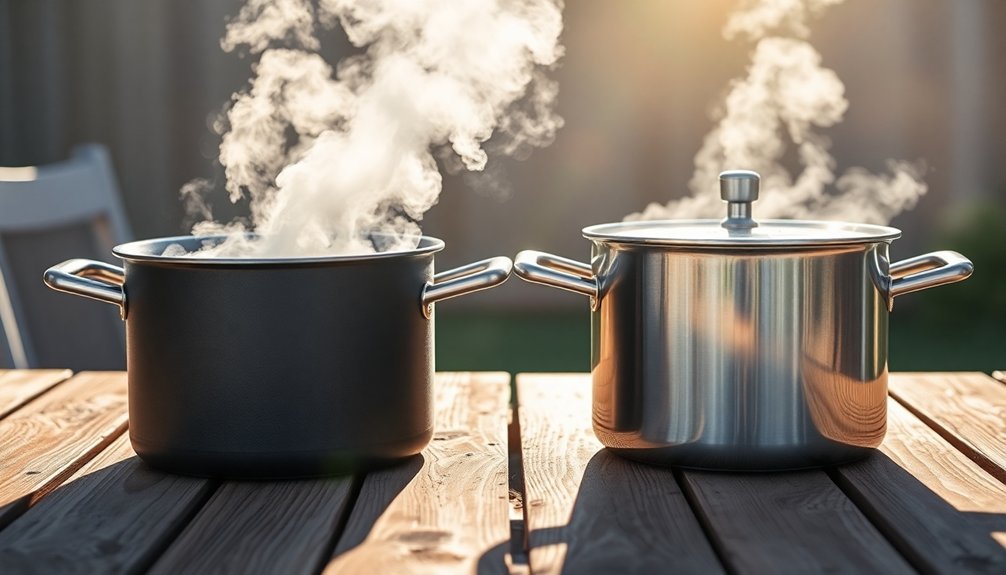
The science behind dark pots reveals a complex interplay of thermal properties that affect cooking speed. When you're cooking with dark pots, especially black steel ones, you'll benefit from their high thermal conductivity and low thermal mass, allowing heat to transfer quickly from the oven to your food.
Dark pots excel at absorbing and emitting radiation more efficiently than their lighter counterparts. This advantage becomes particularly noticeable during your oven's heating cycles, as dark surfaces capture more radiative heat. While dark pots absorb heat quickly, they also cool faster than lighter-colored ones.
The material's thickness also plays a significant role – thinner dark pots heat up faster than thicker ones, regardless of color. You'll notice this effect most prominently with black steel pans, which combine ideal thermal conductivity with minimal mass to achieve superior heating performance.
Heat Absorption Properties
While all cookware can absorb heat, dark pots stand out for their exceptional heat absorption properties. The dark color of these pots allows them to absorb heat more efficiently than their lighter counterparts, making them ideal for outdoor cooking.
You'll notice that dark pots heat up faster due to their higher absorptivity, especially when exposed to direct heat sources. This is due to the principle of reciprocity, where dark surfaces excel at both absorbing and maintaining heat.
When you're cooking outdoors, this becomes particularly significant because a dark pot will capture more of the available heat energy. Dark pots like cast iron have an emissivity of 0.95, making them highly efficient at absorbing and transferring heat.
The thermal conductivity of dark materials, like black steel, also plays an important role. You'll find that these pots transfer heat more effectively to your food, resulting in faster cooking times and more even heat distribution.
Solar Energy and Dark Surfaces
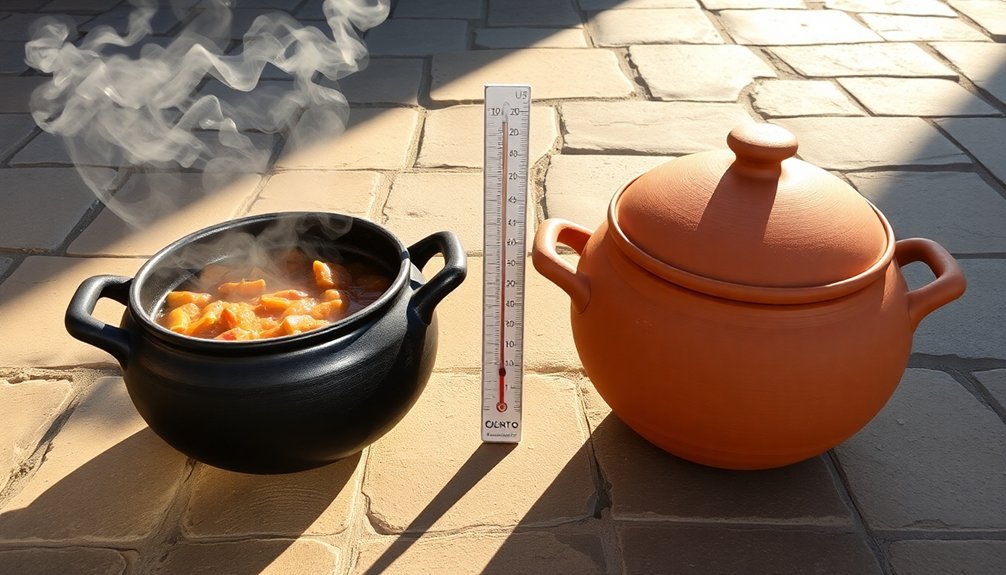
Because dark surfaces excel at converting solar energy into heat, they're particularly effective in solar cooking applications. When sunlight hits a dark pot, it transforms visible and ultraviolet light into infrared radiation, creating heat that cooks your food. This process mimics the greenhouse effect, where heat enters but can't escape easily.
You'll get the best results by using thin, dark-colored pots made of aluminum or steel, as they heat up faster than thicker ones. The peak cooking hours between 10 a.m. and 2 p.m. provide optimal conditions for solar cooking success.
To maximize efficiency, you should place your pot in a transparent plastic bag or under a glass lid – this traps the heated air and prevents it from escaping.
As you cook, you'll need to adjust your setup periodically to follow the sun's movement, ensuring continuous heat absorption throughout the cooking process.
Fuel Conservation Benefits
Building on the same principles that make dark pots effective for solar cooking, these vessels offer considerable advantages in fuel conservation.
You'll find that dark pots require less continuous fuel input because they retain heat more efficiently, allowing you to cook longer with the same amount of energy.
When you use dark pots with proper insulation and tight-fitting lids, you'll greatly reduce your fuel consumption, whether you're cooking with wood, charcoal, or other traditional fuels.
This efficiency translates into real cost savings and environmental benefits. By cutting your food into smaller pieces and using minimal water, you'll optimize the cooking process even further.
In areas where fuel is scarce, this conservation method becomes especially valuable for sustainable cooking practices.
Outdoor Cooking Time Management
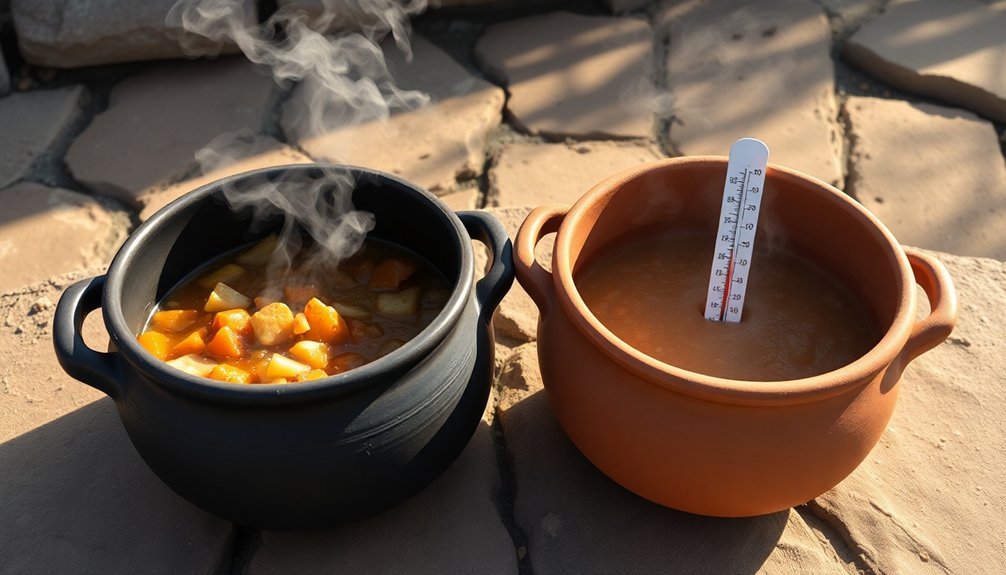
You'll find that dark pots absorb heat more efficiently when cooking outdoors, helping you manage cooking times more effectively in the wilderness.
When planning quick outdoor meals, dark cookware can reduce your overall cooking duration by up to 25% compared to lighter-colored vessels, especially during daylight hours.
Understanding these heat absorption time factors lets you better schedule your meal preparation and avoid keeping hungry campers waiting.
Planning Quick Outdoor Meals
When planning outdoor meals, effective time management becomes essential for an enjoyable camping or outdoor cooking experience. You'll save significant time by prepping ingredients at home and creating a detailed meal plan that includes simple, one-pot dishes. Consider pre-cooking some items and organizing your ingredients in individual containers for quick assembly at the campsite.
| Time-Saving Strategy | Benefit |
|---|---|
| Pre-cut vegetables | Reduces prep time on-site |
| One-pot meals | Minimizes cleanup effort |
| Shared ingredients | Simplifies packing/storage |
| Par-cooked items | Speeds up final cooking |
| Organized storage | Enables quick meal assembly |
Keep your meal plan flexible to accommodate weather changes and outdoor activities. You'll find that using pre-measured ingredients and limiting the variety of dishes helps maintain an efficient cooking schedule while ensuring everyone gets fed on time.
Heat Absorption Time Factors
Several environmental factors greatly influence outdoor cooking times, making it essential to understand and adapt to these variables.
Weather conditions, humidity levels, and altitude all play significant roles in how quickly your food will cook outdoors.
You'll need to adjust your cooking approach based on these key environmental factors:
- Temperature variations affect grill heat stability, with cold or wet weather requiring longer heating times.
- High humidity speeds up cooking by keeping surface heat high.
- Low humidity slows cooking by allowing faster moisture evaporation.
- Higher altitudes require lower cooking temperatures and longer times due to reduced air pressure.
Understanding heat transfer mechanisms like conduction, radiation, and convection helps you manage these variables effectively.
Temperature Control and Distribution
You'll find that dark pots create more predictable heat zones due to their superior radiation properties, making it easier to control cooking temperatures.
The black surface promotes even heat distribution through enhanced radiation, which means your food cooks more uniformly from all angles.
Managing these heat zones becomes intuitive as the dark surface provides consistent heating patterns across the pot's entire cooking area.
Heat Zone Management Basics
Managing heat zones effectively stands as a fundamental skill in both grilling and stovetop cooking.
You'll need to understand how to create and control different temperature areas to achieve the best results for various foods. For dark pots cooking outside, proper heat zone management becomes even more essential as these pots absorb and distribute heat differently.
- Set up distinct zones by adjusting burners to different levels – high for searing and low for gentle cooking
- Monitor internal food temperatures with a calibrated thermometer to guarantee food safety
- Use indirect heat for larger cuts to prevent burning while ensuring thorough cooking
- Maintain proper temperature control to avoid the danger zone between 41°F and 135°F
Even Cooking Through Radiation
While all cookware transfers heat through multiple mechanisms, radiation plays a particularly essential role in dark pots and pans. Your dark-colored cookware absorbs more light radiation, heating up faster and distributing that heat more effectively to your food. This absorption advantage is especially noticeable when cooking with radiation-heavy heat sources.
| Material Type | Radiation Absorption | Heating Speed |
|---|---|---|
| Dark Steel | High | Very Fast |
| Aluminum | Medium | Fast |
| Clear Pyrex | Low | Slow |
You'll notice better browning results with dark pans in your oven, where radiation from heating elements greatly impacts cooking performance. When you're cooking with dark cookware, you can expect faster heating times and more even temperature distribution, especially if you're using high-quality materials with good thermal conductivity.
Material Choices Matter
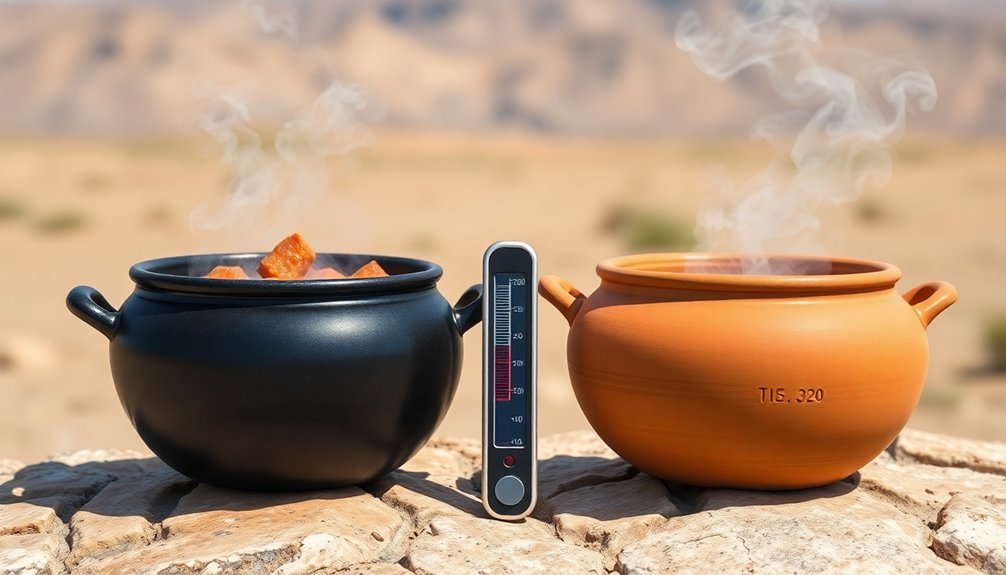
The success of your cooking largely depends on the materials you choose for your cookware.
While copper offers excellent heat conductivity, its high cost mightn't justify the investment. Aluminum provides an efficient and cost-effective alternative, especially in disc-base designs that concentrate heat at the bottom.
When selecting materials for outdoor cooking, consider these key factors:
- Thermal conductivity – aluminum and copper heat up faster than stainless steel
- Material thickness – thinner materials transfer heat more quickly
- Color absorption – darker surfaces absorb heat more efficiently
- Base design – disc-bases distribute heat better than clad designs
Your pot's material thickness also plays a vital role in heat transfer.
Thinner materials heat up faster, but they mightn't retain heat as well as thicker ones.
For best results, choose dark-colored, aluminum-based cookware with a disc-base design.
Maintenance Tips for Dark Pots
Proper maintenance of dark pots guarantees their ideal cooking performance and extends their lifespan. After each use, let your pot dry naturally in an open space or sunlight to prevent mold and fungus formation. Never store it while wet.
For stubborn oil stains or food odors, boil water with lemon slices for 5-10 minutes, then scrub thoroughly.
If you're dealing with a carbon steel pot, maintain its dark surface by regularly seasoning it with high-smoke-point oil until it polymerizes. You'll need to repeat this process if acidic ingredients wear away the seasoning.
For deep cleaning, combine baking soda, lemon juice, and salt, then scrub gently. Avoid harsh chemicals that can damage the surface.
For burned areas, try a mixture of hydrogen peroxide and baking soda.
Environmental Impact of Pot Selection

Your choice of cookware can greatly impact your carbon footprint through fuel consumption and emissions, as dark pots' superior heat efficiency reduces energy usage during cooking.
When you select eco-friendly dark pots made from sustainable materials like recycled stainless steel or cast iron, you'll minimize resource depletion while maximizing heat retention.
Fuel Consumption and Emissions
When choosing cookware for your kitchen, pot selection considerably impacts both fuel consumption and environmental footprint.
Dark-colored pots, especially those with blackened bottoms, absorb heat more efficiently and reduce your fuel usage. You'll find that wider pots also maximize heat exposure, making your cooking more energy-efficient.
Here's how your pot choice affects fuel consumption and emissions:
- Dark surfaces absorb heat better, requiring less fuel to maintain cooking temperatures.
- Wider diameters capture more heat from the flame, reducing wasted energy.
- Hard-anodized aluminum and titanium transfer heat efficiently, lowering fuel needs.
- Well-used, blackened cookware performs better than new, shiny surfaces.
Heat Efficiency Saves Resources
Selecting energy-efficient cookware directly impacts our planet's resources and your utility bills. When you choose well-insulated pots like ThermoPot or use pressure cookers, you'll reduce your energy consumption by up to 70%. These efficient cooking methods help conserve valuable resources while minimizing environmental impact.
You can maximize your cookware's efficiency by matching pot sizes to burner sizes, preventing up to 40% energy waste. High-quality materials like ANSI 304 stainless steel guarantee better heat conduction and retention, while features like pot skirts can improve heat transfer efficiency by 10-30%.
Sustainable Cooking Practices
Making sustainable choices in cookware extends far beyond simple energy efficiency.
When you select dark pots for outdoor cooking, consider their material composition and shape for maximum environmental impact. Well-designed cookware can notably reduce your carbon footprint through better heat retention and distribution.
To make environmentally conscious choices, prioritize these key factors:
- Choose durable materials like heavy stainless steel or cast iron that retain heat and last for years.
- Select pots with ideal shapes that minimize heat loss and maximize cooking efficiency.
- Buy from local manufacturers to reduce transportation emissions.
- Maintain your cookware properly to extend its lifespan.
Best Practices for Outdoor Cooking
To maximize your outdoor cooking experience, understanding and implementing proper techniques can make the difference between a mediocre meal and a fantastic feast. You'll need to master basic grilling methods, whether using gas or charcoal, and guarantee you're following proper safety protocols.
| Essential Tips | Key Actions |
|---|---|
| Fire Safety | Clear area of brush, keep lid handy, monitor constantly |
| Food Prep | Pre-measure ingredients, use zip-top bags, pack seasonings |
| Tool Selection | Pack sharp knives, heavy-duty foil, pot holders |
Pre-planning is vital for success. Store your ingredients properly in insulated coolers, keeping raw and cooked foods separate. For efficient cooking, choose dark-bottomed cookware or well-seasoned cast iron, and opt for wider pots to maximize heat absorption. Consider portable stoves for convenience, and don't forget to keep hot water ready for cleaning your workspace and utensils.
Frequently Asked Questions
Can Dark Pots Affect the Taste of Food Compared to Lighter Ones?
While dark pots won't directly change your food's taste, they'll enhance browning and caramelization through better heat absorption. You'll notice richer flavors from this improved browning process when cooking your meals.
Are Dark Pots Safe for Cooking Acidic Foods Like Tomato-Based Dishes?
You'll want to avoid dark aluminum or cast iron pots for acidic foods, as they can leach metals into your dishes. Instead, use stainless steel, ceramic, or glass cookware for safer tomato-based cooking.
Do Dark Pots Perform Differently at High Altitudes Versus Sea Level?
You'll find dark pots perform similarly at any altitude – they'll absorb heat efficiently regardless of elevation. However, altitude's effects on boiling points and cooking times remain the same as with any cookware.
How Does Humidity Affect the Cooking Speed of Dark Pots Outdoors?
When you're cooking outdoors, high humidity slows your dark pot's heat loss through evaporation, which can speed up cooking. However, you'll notice the pot's surface temperature stays more consistent in humid conditions.
Can Dark Pots Be Effectively Used With Induction Heating Sources Outdoors?
Yes, you can use dark pots with induction heating outdoors if they're magnetic. You'll get the same efficient heating as indoors, but make sure your induction cooktop has proper power supply and weather protection.
In Summary
Dark pots are your best choice for efficient outdoor cooking. You'll save time and fuel by using them since they absorb and retain heat better than light-colored alternatives. By understanding the science of heat absorption and making smart material choices, you're not only cooking faster but also reducing your environmental impact. Keep your dark pots well-maintained, and they'll continue to serve your outdoor cooking needs effectively.

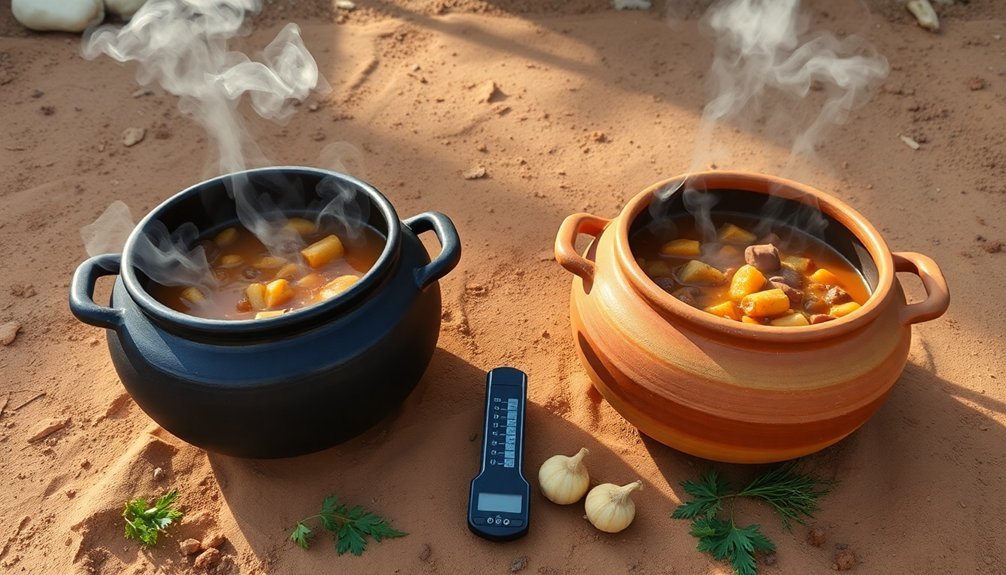
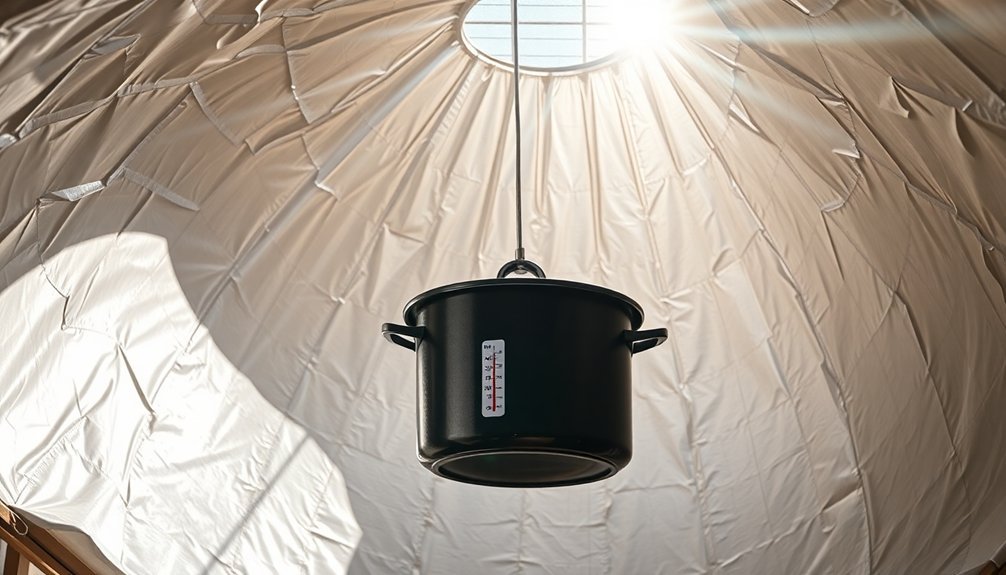

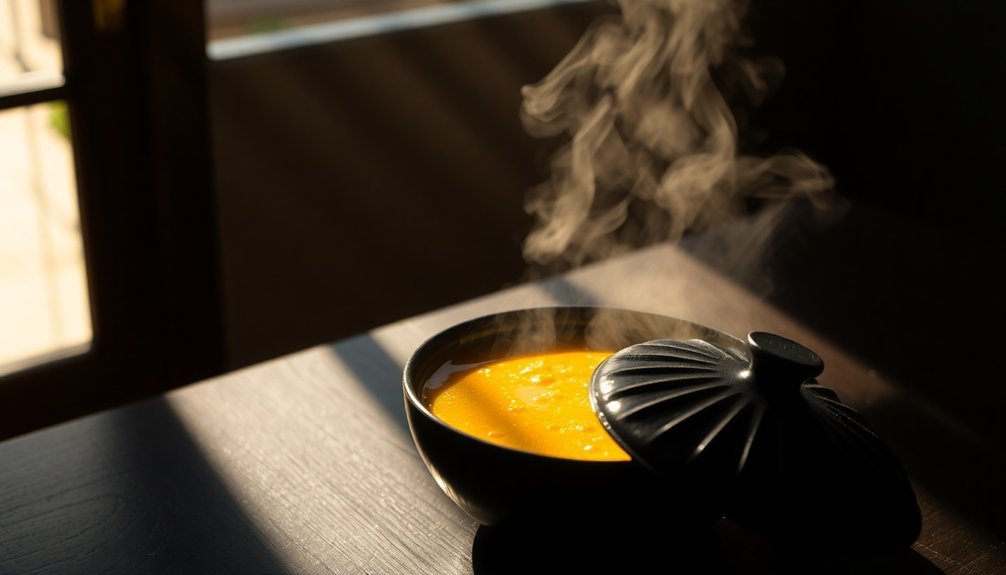
Leave a Reply